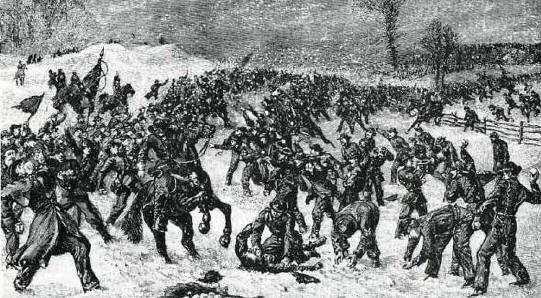|
A Snowball's Chance
Bernadette Loeffel Atkins
During the American Civil War, the winter months gave many troops, both Union and Confederate, an opportunity to rest and recover from three seasons of fighting and marching. In their leisure time, the soldiers would write letters home, play cards and games, read or tell stories. Life in winter camp could become both boring and monotonous. As weeks of inactivity and
confinement built up, tempers quickened and quarreling and fighting increased.

To release the tension and boredom of their daily lives, the soldiers sought relief in the winter sport of snowballing. From the first arrival of a few inches of snow until the melting of the snow's remains in spring, snowballing was the most popular sport in camp. It was more than just a sport between the soldiers, at times a minor snowball skirmish turned into a
full-scale battle, complete with bruises, black eyes, gashed faces and even broken bones. Some of the over-zealous soldiers would fill the core of the snowballs with rocks or lead. At times, snowball battles were fought with such vigor that many of the participants were severely injured requiring first aid. Many soldiers would build up a surplus of the frozen white missiles in
advance.
Wilbur Fisk, 2nd Vermont Infantry recalled, "We had glorious sport this forenoon snowballing...Snowballs flew thick and fast, some of the foremost on each side getting completely plastered over with them, head, ears, neck and all..."
Albert Harris, a Vermonter, wrote home to his brother, "The Conal broak one Lieutenant's nose." In the journal of E.Mussence in the Washington Artillery Papers, the Louisianian diarist states, " Cap CH Slocomb lost two front teeth-Lieut Challeron a blackeye-Among the privates of the 5th Co was 5 bloody noses a Blackeye all of them more or less bruised..."
A New Hampshire participant observed, "tents were wrecked, bones broken, eyes blacked, and teeth knocked out - all in fun."
General Joseph Hooker, concerned about his dispirited men, even set up formal regimental snowball fights, complete with officers on horseback. Not all of the officers encouraged snowballing. In the diary of Edwin B. Weist at Camp Pitcher, he writes, "Some of our boys and the Zouaves got to snowballing and had a big time of it. It would probably ended in a fight if
the officer of the day had not came around and put a stop to it."
William Fletcher, 8th Texas Cavalry wrote, "...All were defeated; all were victorious...with but two reported injured to mar the day's pleasure. There was an order issued prohibiting general snowballing."
Many snowball fights were well documented and written up like an official report as was the Great Snowball Battle of the Rappahannock Academy in February of 1863 and the Battle of the Snow in March of 1864.
As long as there was an abundance of snow and bored, homesick soldiers, a snowball fight was guaranteed to evolve. John S. Jackson, 9th Kentucky Infantry sums up the sentiments of many soldiers, "We have seen more fun today than at any other time during the war."
Ms. Loeffel-Atkins is a native New Yorker and has lived in Gettysburg, PA for the past 15 years. She is an author and co-owner of Battlefields & Beyond Book Shoppe and Gettysburg Publishing Company.
Read other articles on the Civil War
|